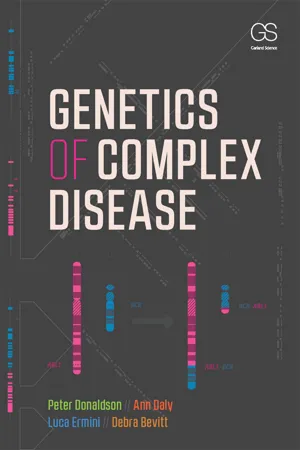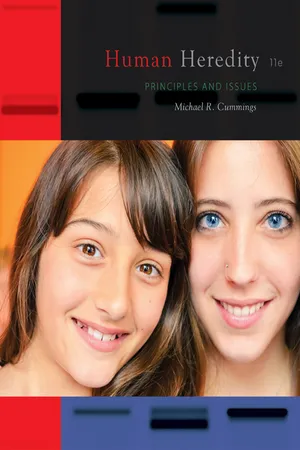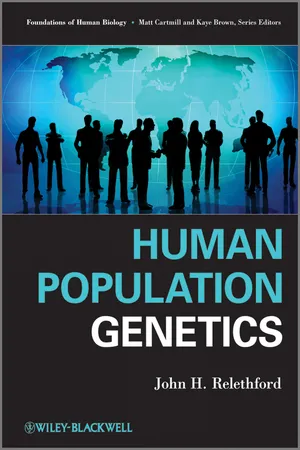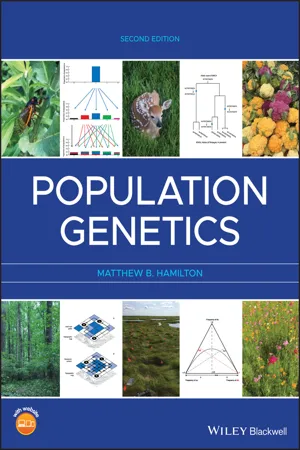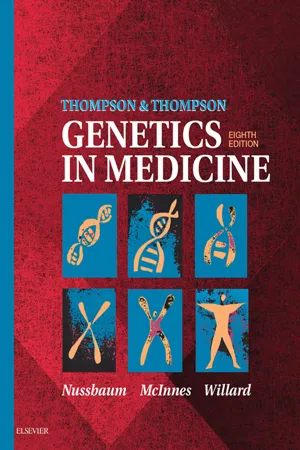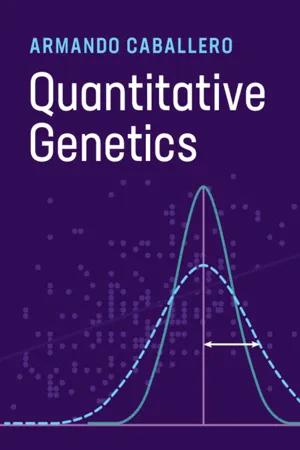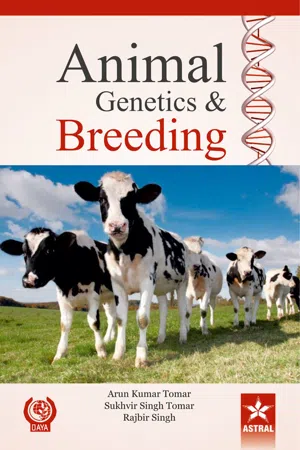Biological Sciences
Allelic Frequencies
Allelic frequencies refer to the relative proportions of different forms of a gene (alleles) within a population. These frequencies are influenced by factors such as genetic drift, natural selection, and gene flow. Understanding allelic frequencies is important in studying genetic diversity, population genetics, and evolutionary processes.
Written by Perlego with AI-assistance
Related key terms
1 of 5
10 Key excerpts on "Allelic Frequencies"
- eBook - PDF
- Peter Donaldson, Ann Daly, Luca Ermini, Debra Bevitt(Authors)
- 2015(Publication Date)
- Garland Science(Publisher)
A large number of samples from a population are usually collected, and the genotype and allele frequencies are calculated. The genotype and allele frequencies of the sample popu-lation are then used to estimate the diversity of the population. To calculate a genotype frequency, the number of individuals having the same genotype is divided by the total number of individuals in the sample ( N ). For a locus with three genotypes, AA , Aa , and aa , the frequency ( f ) of each genotype is: f AA AA N ( ) = number of individuals Figure 1.11: Red blood cells in sickle cell disease. Sickle cells are shaped like a harvesting sickle and, unlike the normal doughnut-shaped red blood cells, these cells can be hard with sharp edges that can damage the wall of small blood vessels as they passage through the body. They will often clog the flow of blood and break up as they pass through the small blood vessels. CHAPTER 1 Genetic Diversity 20 f Aa Aa N ( ) = number of individuals f aa aa N ( ) = number of individuals The sum of all the genotype frequencies always equals 1 (or 100%). Genotypes are not permanent. They are disrupted in the processes of segregation and recombination that take place when individual alleles are passed to the next generation through the gametes. Alleles, in contrast, are not broken down and the same allele may be passed from one generation to the next. For this reason the calculation of allele frequencies is often the preferred choice when determining the genetic variability of a population. In addition, there are always fewer alleles than genotypes, e.g. for the gene with two alleles A and a above, there are two alleles, but there are three genotypes. By using alleles, popula-tion diversity can be described in fewer terms than by using genotypes. Finally, by using allele frequencies in case control population studies rather than genotype frequencies, no assumptions about the impact of homozygosity or of heterozygote advantage are being made. - eBook - PDF
Human Heredity
Principles and Issues
- Michael Cummings(Author)
- 2015(Publication Date)
- Cengage Learning EMEA(Publisher)
It can also be used to detect when allele frequencies are shifting in the population. Changing allele frequencies in a population represent evolutionary change. One of the law’s most common uses is to measure the frequency of heterozygous carriers of deleterious reces-sive alleles in a population. This information can be used to calculate the risk of having an affected child. 19-4 Measuring Genetic Diversity in Human Populations ■ All genetic variants originate by mutation, but mutation is an insignificant force in bring-ing about changes in allele fre-quency. Other forces, including genetic drift, act on the genetic variation in the gene pool and are responsible for changing the frequency of alleles in the population (which is evolution). Drift is a random process that acts in small, isolated populations to change allele frequency from generation to generation. Examples include island populations and those separated from the general population by socioreligious practices. Natural selection acts on genetic diversity in populations to drive the process of evolution by changing allele frequencies. 19-5 Natural Selection Affects the Frequency of Genetic Disorders ■ Selection increases the reproductive success of fitter genotypes. As these individuals make a disproportionate contribution to the gene pool of succeeding generations, South Pacific Ocean North Atlantic Ocean South Atlantic Ocean South America North America Africa Tristan da Cuhna © Cengage Learning Copyright 2016 Cengage Learning. All Rights Reserved. May not be copied, scanned, or duplicated, in whole or in part. Due to electronic rights, some third party content may be suppressed from the eBook and/or eChapter(s). Editorial review has deemed that any suppressed content does not materially affect the overall learning experience. Cengage Learning reserves the right to remove additional content at any time if subsequent rights restrictions require it. - eBook - PDF
Introducing Genetics
From Mendel to Molecules
- Alison Thomas(Author)
- 2014(Publication Date)
- Garland Science(Publisher)
The rediscovery of Mendel’s work, 19 years after Darwin’s death, and the subsequent develop-ment of the concept of the gene and alleles, established an understanding of how the mechanism of inheritance could lead to variation. During the early 1900s, the British mathematician Godfrey Hardy (1877–1947) and the German physician Wilhelm Weinberg (1862–1937) each independently produced a set of equations enabling the variation present in populations to be expressed in terms of allele and genotype frequencies. This chapter: • Shows how the variation present in a population can be analyzed in terms of allele and genotype frequencies • Discusses the impact upon the observed variation of crucial features of the population such as its size, mating patterns, or selective forces 10.1 Population genetics: some definitions A population can be defined as a local group of a single species within which mating is actually or potentially occurring. The interbreeding individuals share a common set of genes referred to as the gene pool . It is the characteristics of the gene pool that are studied in population genetics (e.g. frequencies of dif-ferent alleles and resulting genotypes in the sample group). Remember that a frequency refers to a proportion, and always ranges in value between 0 and 1. For example, if 19% of people in a group are left-handed, then the frequency of left-handedness in this group is 0.19. The first step in studying the variation pres-ent in a population is to measure the frequency of different alleles for individual genes. Population geneticists are often interested in knowing how many loci are polymorphic (i.e. possess two or more different alleles with the frequency of the rarest exceeding 0.1%). The more loci that are polymorphic, the more variation the population shows. 157 The Hardy–Weinberg law 10.2 Calculating allele frequencies Allele frequencies may be calculated in one of two ways. - eBook - ePub
- John H. Relethford(Author)
- 2012(Publication Date)
- Wiley-Blackwell(Publisher)
. We can do this for all three genotypes:Although it might seem obvious, it will be important later to see that the sum of the genotype frequencies adds up to 1 (0.36 + 0.48 + 0.16 = 1.0). Although we use genotype frequencies in population genetics, note that we could also express these proportions as percentages by multiplying each proportion by 100: AA = 36%, Aa = 48%, and aa = 16%. Note that these add up to 100%.At this point, it is useful to consider another characteristic of genotype frequencies. Suppose that you were to return to this population and choose a single person at random without knowing that individual's genotype. What is the probability that this person would have the genotype AA ? The answer is 0.36, which is the genotype frequency, because this number also represents the number of times that a specific event occurs (54 people have genotype AA ) divided by the total number of events (there are 150 people).2.1.2 Computing Allele FrequenciesYou can see that it is easy to estimate out the relative frequency of any genotype; you simply divide the number by the total number of all genotypes. What about the frequency of an allele? What are the number of A alleles and the number of a alleles in the hypothetical population described above?2.1.2.1 Two AllelesThe answer to these questions may not be immediately obvious. I have found that many students understand better the concept of allele frequency using an analogy. Imagine there are 150 people each wearing two socks (one on each foot). For reasons unknown to us (you are welcome to make one up), some of the people are wearing two black socks, some are wearing a black sock and a white sock, and some are wearing two white socks. Suppose that you count them up and come up with the following numbers: - eBook - PDF
- Matthew B. Hamilton(Author)
- 2021(Publication Date)
- Wiley-Blackwell(Publisher)
The allele states are the numbers of repeats at that locus (see Box 2.1). Allele frequencies (Freq) are as reported in Budowle et al. (2001). Table 1 from FBI sample population. D3S1358 vWA D21S11 D18S51 D13S317 Allele Freq Allele Freq Allele Freq Allele Freq Allele Freq 12 0.0000 13 0.0051 27 0.0459 <11 0.0128 8 0.0995 13 0.0025 14 0.1020 28 0.1658 11 0.0128 9 0.0765 14 0.1404 15 0.1122 29 0.1811 12 0.1276 10 0.0510 15 0.2463 16 0.2015 30 0.2321 13 0.1224 11 0.3189 16 0.2315 17 0.2628 30.2 0.0383 14 0.1735 12 0.3087 17 0.2118 18 0.2219 31 0.0714 15 0.1276 13 0.1097 18 0.1626 19 0.0842 31.2 0.0995 16 0.1071 14 0.0357 19 0.0049 20 0.0102 32 0.0153 17 0.1556 32.2 0.1122 18 0.0918 33.2 0.0306 19 0.0357 35.2 0.0026 20 0.0255 21 0.0051 22 0.0026 FGA D8S1179 D5S818 D7S820 Allele freq Allele freq Allele freq Allele Freq 18 0.0306 <9 0.0179 9 0.0308 6 0.0025 19 0.0561 9 0.1020 10 0.0487 7 0.0172 20 0.1454 10 0.1020 11 0.4103 8 0.1626 20.2 0.0026 11 0.0587 12 0.3538 9 0.1478 21 0.1735 12 0.1454 13 0.1462 10 0.2906 22 0.1888 13 0.3393 14 0.0077 11 0.2020 22.2 0.0102 14 0.2015 15 0.0026 12 0.1404 23 0.1582 15 0.1097 13 0.0296 24 0.1378 16 0.0128 14 0.0074 25 0.0689 17 0.0026 26 0.0179 27 0.0102 19 Genotype frequencies approach a unique, individual identifier. Therefore, there is a finite chance that a suspect will match an evidence DNA profile by chance alone. Such DNA profile matches, or “inclusions,” require addi- tional evidence to ascertain guilt or innocence. In fact, the term prosecutor’s fallacy was coined to describe failure to recognize the difference between a DNA match and guilt (for example, a person can be present at a location and not involved in a crime). Only when DNA profiles do not match, called an “exclusion,” can a suspect be unambiguously and absolutely ruled out as the source of a biological sam- ple at a crime scene. Current forensic DNA profiles use 10–13 loci to estimate expected genotype frequencies. - eBook - PDF
An Introduction to Genetics for Language Scientists
Current Concepts, Methods, and Findings
- Dan Dediu(Author)
- 2015(Publication Date)
- Cambridge University Press(Publisher)
Therefore, it is not intended to be a general introduction to these topics as there are many excellent textbooks such as Halliburton (2004) and Jobling et al. (2013), nor does it cover all possible aspects or go into great depth, but instead tries to sample a selection of relevant topics, with an accent on recent developments that might help shed light on language evolution and change. 160 8.1 Foundations of population genetics 161 8.1 Foundations of population genetics: loci, alleles, individuals and populations Until now, we have focused on the molecular aspects of our genome, on how it influences the phenotype and on some of the methods used to find and study such influences. However, individuals are embedded within populations and it is to the populations and their dynamics through space and time that we now turn our attention. From a very abstract point of view, populations are composed of similar individuals, each individual having a genome that can be usefully reduced to a set of loci, each copy of the locus being occupied by one of a set of possible alleles. For example, we might focus on a single autosomal locus that has two alle- les, denoted A and a; therefore, each individual’s genotype at this locus can be either AA, aa (both known as homozygous) or Aa (heterozygous – please note that it is usually assumed that the genotypes Aa and aA are equivalent). Thus, a population with nine individuals might be composed of two homozy- gous aa, five heterozygous aA, and two homozygous AA (see Figure 8.1). In this case, the proportion (or frequency) of aa individuals in the population is p aa = 2 9 ≈ 0.22 = 22%, that of aA individuals is p aA = 5 9 ≈ 0.55 = 55%, and that of AA individuals is p AA = 2 9 ≈ 0.22 = 22%. Please note that the sum of the genotype frequencies of all genotypes present in the population (with possible but absent genotypes having a frequency of 0%) equals 100% (here, p aa + p aA + p AA = 2 9 + 5 9 + 2 9 = 9 9 = 1 = 100%). - Yuri Kartavtsev(Author)
- 2015(Publication Date)
- CRC Press(Publisher)
In Chapter 8, they were just introduced. Now let us look at them in more detail and consider some theoretical background for these parameters. Allele Frequency, p Empirically, under codominance or incomplete dominance, p can be estimated by a direct count of genotypes, as we already discussed (Chapter 4): p A1 = ( 2D A 1 A 1 + H A 1 A 2 )/ 2n = ( D A 1 A 1 + H/2 A 1 A 2 )/ n , (9.1) where p A1 is frequency of A 1 , D is the number in the sample of the genotype A 1 A 1 , H is the number in the sample of the genotype A 1 A 2 and n is the general number of individuals in the sample. All other allele frequencies are obtained in the same manner. The frequency of the last allele need not be calculated because it is easily determined as in the two-allele case: q A2 = 1 – p A1 ; p A1 is substituted here by the sum of all alleles except one. For the loci that are not linked with sex, the frequencies of alleles and gametes are equal. That is why in a large bisexual population with random mating there is a certain ratio between gamete frequencies and genotype frequencies known as the Hardy-Weinberg law (ratio): ( p + q ) 2 = p 2 + 2pq + q 2 or in general notation for multiple alleles ( p k A ij ) 2 = p 2 k A i A i + 2p k ( 1 – p k ) A i A j , (9.2) where, k = 1,2,3..j are ordered numbers of alleles. The equilibrium ratio between gametic and genotypic frequencies is established in a single generation of a random mating, and persists inde fi nitely, until it is disturbed by the action of natural selection, migration, population decrease or assortative mating that breaks the conditions of equilibrium. For the case of three alleles, the ratio may be written as: (p + q + r) 2 = p 2 + q 2 + r 2 + 2pq + 2pr + 2qr and so on. In a graphic mode, the relation between allelic (gametic) frequencies and genotypic frequencies may be shown as a parabola within a triangle (Fig. 9.1.1). Allele frequency in principle may be considered as the probability of occurrence of an allele.- eBook - ePub
Thompson & Thompson Genetics in Medicine E-Book
Thompson & Thompson Genetics in Medicine E-Book
- Robert L. Nussbaum, Roderick R. McInnes, Huntington F Willard(Authors)
- 2015(Publication Date)
- Elsevier(Publisher)
The previous discussion of the Hardy-Weinberg law explained how, at equilibrium, genotype frequencies are determined by allele frequencies and remain stable from generation to generation, assuming the allele frequencies in a large, isolated, randomly mating population remain constant. However, there is a problem of interest to human geneticists that the Hardy-Weinberg law does not address: Why are allele frequencies different in different populations in the first place? In particular, for the medical geneticist, why are some mutant alleles that are clearly deleterious more common in certain population groups than in others? We address these issues in the rest of this chapter.Differences in frequencies of alleles that cause genetic disease are of particular interest to the medical geneticist and genetic counselor because they cause different disease risks in specific population groups. Well-known examples include Tay-Sachs disease in people of Ashkenazi Jewish ancestry, sickle cell disease in African Americans, and hemolytic disease of the newborn and PKU in white populations (Table 9-5 ).TABLE 9-5 Incidence, Gene Frequency, and Heterozygote Frequency for Selected Autosomal Disorders in Different PopulationsDisorder Population Incidence Allele Frequency Heterozygote Frequency Recessive q 2 q 2pq Sickle cell anemia (S/S genotype) U.S. African American 1 in 400 0.05 1 in 11 Hispanic American 1 in 40,000 0.005 1 in 101 Rh (all Rh-negative alleles) U.S. white 1 in 6 0.41 ≈1 in 2 U.S. African Americans 1 in 14 0.26 ≈2 in 5 Japanese 1 in 200 0.071 ≈1 in 8 Phenylketonuria (all mutant alleles) Scotland 1 in 5300 0.014 1 in 37 Finland 1 in 200,000 0.002 1 in 250 Japan 1 in 109,000 0.003 1 in 166 Dominant 2pq + q 2 q Familial hypercholesterolemia Isolate in Quebec, Canada 1 in 122 0.004 — Afrikaner, South Africa 1 in 70 0.007 — U.S. population 1 in 500 0.001 — Myotonic dystrophy Isolate in Quebec, Canada 1 in 475 0.0011 — Europe 1 in 25,000 0.00002 — The Rh System
One clinically important example of marked differences in allele frequencies is seen with the Rh blood group. The Rh blood group is very important clinically because of its role in hemolytic disease of the newborn and in transfusion incompatibilities. In simplest terms, the population is separated into Rh-positive individuals, who express, on their red blood cells, the antigen Rh D, a polypeptide encoded by the RHD gene, and Rh-negative individuals, who do not express this antigen. Being Rh-negative is therefore inherited as an autosomal recessive trait in which the Rh-negative phenotype occurs in individuals homozygous or compound heterozygous for nonfunctional alleles of the RHD gene. The frequency of Rh-negative individuals varies enormously in different ethnic groups (see Table 9-5 - eBook - PDF
- Armando Caballero(Author)
- 2020(Publication Date)
- Cambridge University Press(Publisher)
In general, changes in allele frequency generated by mutation are extremely slow. The importance of mutation does not reside in these changes in frequency, which are generally negligible, but in the generation of new allelic forms in the whole genome and population. For example, if we consider a population size of N = 1000 individuals and assume that the rate of appearance of new allelic variants per locus and generation is u ≈ 10 −5 , it is expected that 2Nu = 0.02 individuals will be born in the population, that is, two out of every 100, with a mutation in the locus in question. If we consider the whole genome and assume that there are 20,000 loci subject to the same mutation rate, the number of new mutations that would appear in the whole population would be 400 each generation. 2.7 Change in Allele Frequencies Due to Migration Another source of systematic change in allele frequencies that can occur in a population is that generated by immigrant individuals from another population with different frequencies. The simplest model for its study is the so-called island-continent model (Figure 2.6a), where a large population (continent) and a much smaller one (island) are considered, there being a gene flow due to migration between both at a rate m per generation. Given the large relative size of the continent with respect to the latter, the changes by migration only significantly affect the island. If the frequency of allele A in the continent is P , which is assumed invariable, and in the island it is p t−1 in a given generation, the frequency of the allele in the island in the next generation will be p t ¼ p t1 1 m ð Þ þ Pm: ð2:15Þ Subtracting P in each side of equation (2.15) and operating, we have ðp t PÞ ¼ ðp t1 PÞð1 mÞ, from which it follows that the difference in allele frequencies 2.7 Change in Allele Frequencies Due to Migration 27 - eBook - PDF
- Tomar, Arun Kumar(Authors)
- 2021(Publication Date)
- Daya Publishing House(Publisher)
The theory states that there is an increasing consistency to the actual trend (reality) with the increase in number of trails. For example, the occurrence of heads and tails of a coin by tossing come close to the expectation of 50:50 when the numbers of tossing become large but deviates from expectation when the numbers of tossing (trials) are small. Therefore, the consistency of the actual with the expectation depends on the numbers of events (trails) under observation. In case of population of domestic animals, the frequency of two or more alleles of a gene pair are like head or tail of a coin and the number of animals of population are like the numbers of tossing of a coin. The numbers of breeding animals constitute the size of a population. In small size population, the numbers of breeding animals (parents) are small. Therefore, the Allelic Frequencies among parents do not represent the actual frequencies of alleles of the whole population but they deviate from the actual frequencies. These Allelic Frequencies among parents determine the genotypic frequencies of the progeny generation which in turn decides the gene frequency among progeny generation. Therefore, the allele frequencies in different samples of small size are expected to deviate from that of the whole population. 13.4.2 SAMPLING EFFECT The effect of sampling can be seen by considering a single locus with two alleles (A and a) with their equal frequencies as p = q = ½. In a large random mating population, the frequency of A allele is expected to be ½ in progeny generation. But when the population is small, a few numbers of offspring are raised from the large pool of gametes produced from parental population. The gametes are sampled in a small population and the sample is not expected to have equal number of two alleles at a locus but either of the two alleles may be transmitted in greater numbers than the other. This will lead to change the This ebook is exclusively for this university only.
Index pages curate the most relevant extracts from our library of academic textbooks. They’ve been created using an in-house natural language model (NLM), each adding context and meaning to key research topics.
